By Chris Spangler
Four of Whitewater’s historical landmarks are deteriorating and in dire need of restoration.
That was the message that members of the city’s Landmarks Commission shared with 40 people attending a presentation at the Irvin L. Young Memorial Library Tuesday.
The commission outlined the history and repairs needed to save the Birge Fountain, Starin Park water tower, White Memorial Building and Whitewater Effigy Mounts Preserve, and encouraged public action.
There are 27 landmarks in Whitewater, eight of which are city-owned.
“The Landmarks Commission has existed since 1985 … and its main two functions are to nominate and designate local landmarks, which then are protected by local ordinance, and to also provide educational programs such as this,” member Kori Oberle told attendees. “Tonight we are focusing on four local landmarks of varying ages spread out around town, and we’re here simply to provide historical evidence and scientific fact about where they’re at in their lifespans.”
Starin Park water tower
Commission member Dan Richardson reported that the Starin Park water tower was built on Prospect Hill, one of the highest points in the city, in 1889. Its construction was sparked by a fire at the Whitewater Normal School a year before.
“The fire was put out and the damage was repaired rather quickly, but then the city fathers began to realize it was pretty necessary that they have a water system,” he said, noting that there was neither a water nor sanitary sewer system in Whitewater a the time.
The city contracted with the Gray Construction Co. of Chicago, which built the water tower and owned it until 1912, when the city took over.
“When the water tower was first built, they didn’t put a lid on it; it was open. They decided that probably, for health purposes, they should cover it,” Richardson said.
The tower stands about 100 feet tall with eight courses of locally quarried limestone. The base foundation of the tower itself is eight feet thick and the pedestal of limestone rises eight feet up with courses. The tower’s tank held 185,000 gallons of water, or about 770 tons.
“So the eight-foot base narrows down to about four feet at the steel tank at the top,” Richardson said, noting that it was decommissioned when the new water tower went into use late last year.
“A couple years ago if you’d walk by, you would have noticed that pieces of stone the size of your fist, some even bigger, had fallen off the building, and it was a cause for concern,” he said.
Last year, Cornerstone Restoration of Sullivan performed tuckpointing on the 80-foot stone portion of the tower, much of it in the interior.
Cornerstone reported structural problems with the water tower, prompting the city to hire McEnroe Consulting Engineers of Wauwatosa to undertake a structural study.
“They found quite a few things wrong with the water tower, but that imminent collapse is not evident,” Richardson said.
What McEnroe did find included:
• The stone belt courses that encircle the tower need replacement.
• The entire masonry exterior needs to be cleaned.
• Mortar wash comes off of the top of the tower under the steel tank, as well as the base of the masonry wall.
• The top of the tower wall should be replaced completely.
• There are a number of places where stones need to be replaced, arches need to be fixed, exterior joints need to be tuckpointed and cracks need to be filled.
“They also indicated that there’s been no structural study of the tank at the top of structure at this point, but there are repairs that probably need to be made at the base; that’s as far as it went,” Robertson said, adding that various steel repairs are necessary, including the interior ladder, and doors in at least five locations require replacement.
McEnroe recommended an eight-step process for repairs, divided into three phases.
He said that phase one includes repairing the masonry seal at the top of the tower, considering repairing the entire top of the tower, continuing work down the tower as funding allows, and fixing missing stone and cracks that are of major concern.
“The cost of phase one was equivalent to the cost of tearing it down,” Robertson said of the water tower, noting that the phase-one repairs would cost $590,000 while demolition of the tower would be $600,000, in 2023 dollars.
The next two phases would continue repairs throughout the structure.
“And then, of course, you get to the end, not considering the steel tower at the top, and the building needs to be maintained,” he added.
One attendee asked why nobody noticed the deterioration throughout the years.
“We’re really not sure, but we don’t want to put blame over time. Whether they were employees or volunteers, we’re very grateful that these artifacts have been taken care of to the extent that they have been and that they’re still with us,” Oberle said. “That’s the road that we’re traveling.”
Attendee Doug Anderson pointed out that deterioration will speed up now that the tower is not in use.
“As they age, they come apart, and that’s natural,” he said. “It’s been in use; now it’s not going to be used and this is the perfect time to evaluate it.
“I think that you guys were really responsible in taking it over. The city could have said ‘you know, it’s $600,000 and we’re done’ or ‘it’s $600,000 and every five years or 10 years or 20 years we’re going to have to come up with other big sums.’ And not being in use, it’s going to deteriorate more than being in use,’” Anderson added.
Oberle emphasized that the Landmarks Commission is limited in how far it can go.
“We have no fiduciary ability so the best we can do, charged with preservation and education, is call attention to the fact that something needs attention and that’s what we’re trying to do,” she said.
The commission was asked whether, even after the suggested repairs, the interior of the water tower would be able to be toured like the tower in Fort Atkinson.
Richardson said that the Starin Park water tower has a rusty ladder in the interior, not stairs like Fort Atkinson’s tower.
“That rather substantial staircase is not the original or a reproduction. That was added to be for tourists like us and so, depending on what happens in the future to the water tower, that could be installed if enough people had deep enough pockets to make it happen and the city agreed to let it happen,” Oberle said.
She handed out common council and city officials’ contact information, urging attendees become involved and take their concerns to those in power.
Effigy Mounds Preserve
Oberle said that in 2024, the city will have owned the Effigy Mounds Preserve for 50 years and it will have been a local landmark for 30.
“Over the last five years — again, we’re not pointing any blame, but we could give Mother Nature a slap on the back for not cooperating — the landscape has gone wild,” she said. “We could do a nice TV series on landscapes gone wild there.”
Oberle noted that the 13 mounds need to be measured by archaeologists. The walking path has disappeared beneath overgrown plants and trees, and state statutes have increased the buffer around mounds from five to 15 feet.
“We have a big expense, the city does, to restore the landscape so that a new path can be laid that allows the archaeologists in there to measure them,” Oberle said.
She noted that mature trees are growing at the edges of the mounds and within the five-foot buffer. Should a windstorm pull them up by the roots, the city would be breaking state statutes by disturbing the ground.
“In some cases, part of the softening of the landscape issue is to remove trees at the surface and let the stumps just biodegrade,” Oberle said.
The invasive weeds and trees have grown taller than the preserve’s signs in the five years since landscape maintenance was discontinued.
Oberle said that in September 2021, the Landmarks Commission presented a more-detailed program on the mounds preserve to the common council and wrote a letter to the city manager. As a result, a onetime $25,000 was earmarked for 2023 to be used toward some of the management issues and, hopefully, the archaeological measurement, according to Oberle.
In addition, the commission is in the final throes of applying for state grant that, if approved, would match the $25,000 city monies. It would be used for outfitting the empty lot that sits on Indian Mounds Parkway.
“It’s just a green empty space. It has a sign on it and a pine tree and a display guide. We would like to turn it into the most enchanting people-centered destination park in the world,” Oberle said. “I said destination park. It’s not a Disney park. It’s a place for people to go and find community in the tradition of all of the native peoples that came and went from the preserve during thousands of years and celebrated and performed rituals.”
She described the area as having places where people can gather, eat and drink and exercise.
“There’s a place for doing yoga, there’s a play area with cool things made out of tree parts and a magnification station and a mounted telescope looking into the preserve,” Oberle explained. “There’s a path that runs through the middle, which is our very best marketing device because it signals to anyone walking, biking or driving by that it’s the yellow brick road and ‘let’s go see what’s at the end.’ … Then people will be curious to find out about more of what’s inside.”
She said the area is being called the preserve gathering space. It will not be known until May whether the grant will be awarded.
“Several of us in the community are committed to doing some private fundraising if the grant isn’t awarded so we can make something happen,” Oberle added.
White Memorial Building
The White Memorial Building is so named because it was a gift from Mary Flavia White and her family in 1904.
Oberle said it is one of about two-dozen library buildings in Wisconsin designed by Cloud and Stark, a team of architects in Madison. It is a Carnegie library, having received funding from the Andrew Carnegie Foundation with the requirement that it be designed by a local architect.
“It is architecturally significant for Whitewater, but also beyond,” Oberle said. “It is a candidate for the National Register of Historic Places as a structure, even though being a city landmark provides it more protection through the municipal code. The national register listing and the state listing are purely honorary. They’re feathers in the cap.”
Unfortunately, she said, moisture has gotten in between the bricks and freezing and contracting has caused mortar to fall out.
“On all four sides of the building — and it’s a big building — I was able to stick my little finger and my ring finger in between most of the bricks. It needs tuckpointing bigtime,” she continued. “Every time it rains and rain is blown by the wind, water gets in there and causes damage. It’s not just sitting there looking nice. It’s kind of like aging before our eyes.”
Also needed is a new roof on the non-original portico, she said.
Several attendees offered remarks on the White Memorial Building’s condition.
“Once the roof goes, it’s dead.” Dr. Roy Nosek said.
Again, a woman asked why the deterioration hadn’t been noticed in the past.
“I’m old enough to know that we often don’t look in our own backyard at the things we don’t see every day; that’s kind of human nature, and I also don’t want to point any fingers,” Oberle responded.
As an example, she recommended that people take a look at the roof of the current library, which was built circa 1992.
“I feel terribly negligent, having come back to town after 30 years away, that it’s taken me until now to look closely in my own backyard,” Oberle said. “But I feel totally powerless to make any changes.”
She said she has worked for other municipalities and the state of Wisconsin, and usually there are staff responsible for facility management.
“I think we all may have been assuming that was the case and that everything’s going the way it should go. That’s why we’re having this conversation. Not to point blame and get emotional about it, but to say ‘hey people, it could be 1971 all over again.’ … That’s my tagline, because in 1971, the original city hall, which sits on a parking lot now, was torn down and many people were surprised because they didn’t know that it had gotten to the point where it was the only course of action,” Oberle said, adding that the same thing happened to the old stone mill.
She again encouraged residents to contact city officials, and an attendee suggested as well to talk to state representatives about state funding coming to local municipalities.
“There’s also the preservation ethic. We are sort of like taking that for granted, I think, in this community and we are at risk of losing the unique features that make Whitewater what it is,” Oberle said. “What will be put on library park when the building falls down and the fountain caves in? What will we put there?”
Birge Fountain
Pat Blackmer, chairperson of the Landmarks Commission, shared the history and problems with the Birge Fountain, located at the triangle — also known as flatiron and library park — in front of the White Memorial Building.
“Isn’t it a wonderful piece of public art? It’s really iconic. It’s one of the things that, when you think about Whitewater, you think about the water tower, but everyone sees this, particularly when they’re driving by. And we’re so fortunate that it was a gift,” she said.
Julius Birge was the first child of European settlers to be born in Whitewater, in 1839. Blackmer said that although he lived here only during childhood, Birge was so attached to the city that he donated the fountain.
It was installed on July 4, 1903, on the former site of the one-room brick school that Birge attended as a child, and was made a local landmark in 1985.
“The fountain really, really became a significant and historic part of Whitewater,” Blackmer said.
The catalog fountain was created by J.W. Fiske & Co., an ironworks company in New York.
“It consisted of the maid of the mist and the cherubs on dolphins. There are two nearly identical fountains, in Nova Scotia and Lancaster, Ohio. Both are larger,” she explained.
The cherubs were replaced in 1983 by a University of Wisconsin-Whitewater art professor and his students after vandals stole and damaged one of them. In 1998, the wooden teepee covering the fountain in winter was vandalized, damaging the maid of the mist. She was then recast in bronze.
Blackmer said that not only do the elements need microabrasion, but they also need to be returned to their statuary color of bronze and possibly lacquered. In addition, the iron base, column and basin are corroding from the inside out.
She said that in 2017, the Landmarks Commission suggested undertaking a virtual assessment of the fountain. McKay Lodge Laboratory of Oberlin, Ohio, did an assessment, discovering severe corrosion.
“They projected that by 2027, we would have to take the fountain apart, disassemble it, soft-package it and send it in for conservation,” Blackmer said. “It’s 2023. We have a very short time.”
She noted that the maintenance and care of the fountain have increased its longevity, as they were found to be adequate and, in some cases, exceptional, according to the report.
Triage for the fountain is very important, Blackmer said. First steps would include removing corrosion to stabilize the pedestal, treat the cherubs and also replace the concrete base.
“So we are looking at an expense. We are looking at the fact that this is an iconic, artistic, culturally significant part of the city of Whitewater and dear probably to all of your hearts,” Blackmer said.
Nosek, a former city council member, said the metal exterior of the fountain has been painted periodically. He asked whether it was recommended that the rust and paint be removed while the fountain remained intact.
“They suggested disassembly of the entire fountain,” Blackmer replied.
“It’s been almost 125 years and the only thing that has been given rust treatment is the exterior of that fountain,” Nosek said, cautioning that disassembling and sending it off to be repaired could take as long as a year.
“Microabrasion of the cherubs has been done twice by local sandblasters,” he added. “Microabrasion is a big word that you don’t have to take to Ohio to accomplish. We’ve done it here two times.”
Blackmer said that sandblasting was not recommended by the conservator. However, Nosek disagreed.
“This is bronze. Bronze will take a howitzer shell and bounce off. You can microabraise a bronze statue and bring it back to its original cast appearance. Believe me, there are bronze statues that are as old as Jesus,” he said.
Nosek showed more photos of the fountain to interested people after the program.
Blackmer, meanwhile, said that the 2017 conservator’s report estimated that it would cost $100,000 to $125,000 to do the work, including non-triage items such as changing lighting and the pump.
“The conservator needs to do the cherubs and the ironwork,” she said. “Contractors within our locality could do the rest of the work. They could do the painting, and, certainly, the cement work that needs to be done for the base. Those could all be done locally. So when they gave us the figure, they estimated rather on the high end rather than the low end.”
Winding down the program, Oberle reiterated the importance of contacting city officials and having residents step forward to lead fundraising efforts.
“What we’re hoping is that there will be momentum from this meeting that will result in the creation of an ad hoc committee of representatives of all the different factions in the community, and one of the things they do is set up a tax-deductible place to park that money,” she said. “But right now, we are still in the early stages of trying to draw public attention to this, so we would be happy to take this talk on the road …”
The Whitewater Community Foundation is able to be the conduit for such fundraising, a representative said.
“We need to act before the few Landmarks members need restoration themselves, because we’re getting pretty tired of being the carriers of the light on this and being continually shot down and told things that are not true,” Oberle concluded. “And I’m not trying to point blame, but I’m just saying, if you guys care at all, get involved.
“If we don’t stand up, they’re going to fall down.”
A link to the 53-page “Starin Water Tower Structural Analysis Report created by McEnroe Consulting Engineers, LLC, is here: http://fortatkinsononline.com/wp-content/uploads/2023/01/McEnroe-assessment-of-water-tower_final.pdf.

Pat Blackmer, chair of the Whitewater Landmarks Commission, outlines the repairs needed for the Birge Fountain during a program Tuesday. Chris Spangler photo.
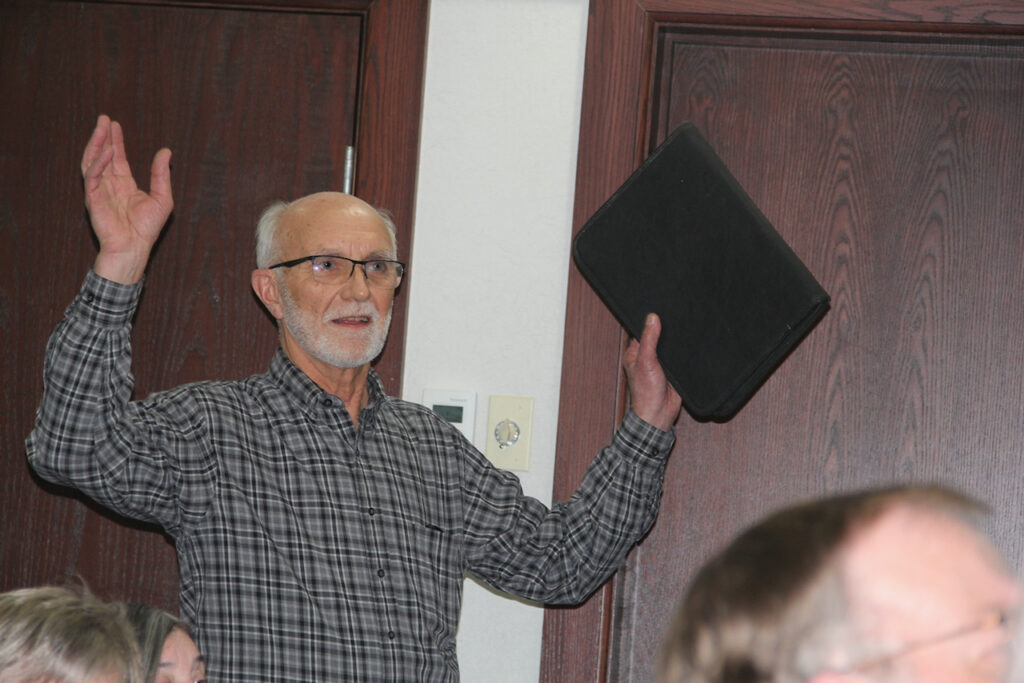
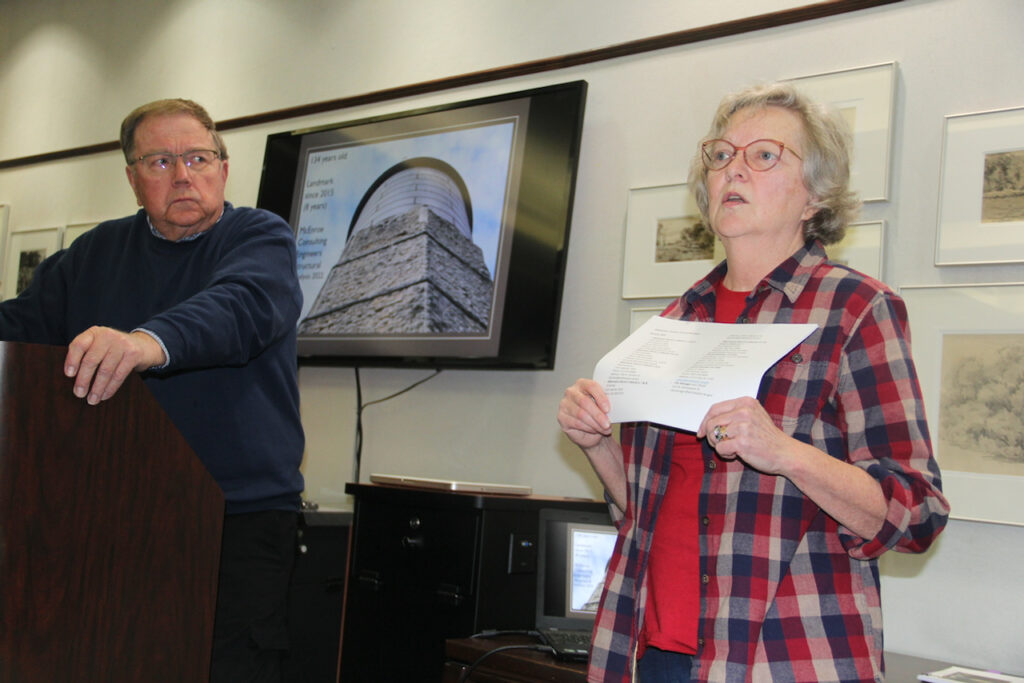
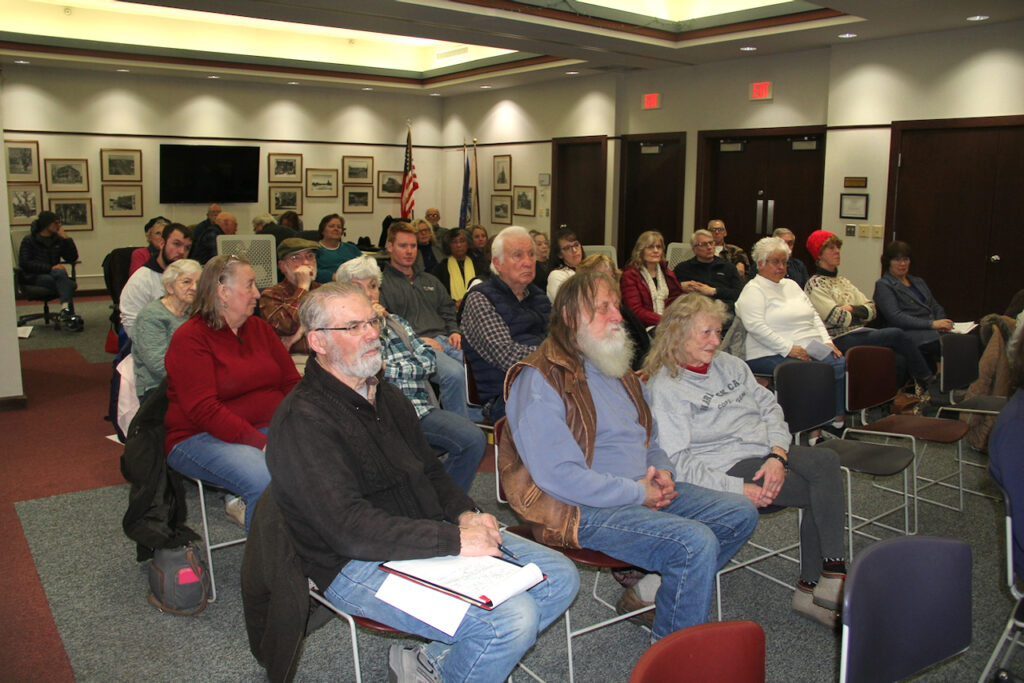
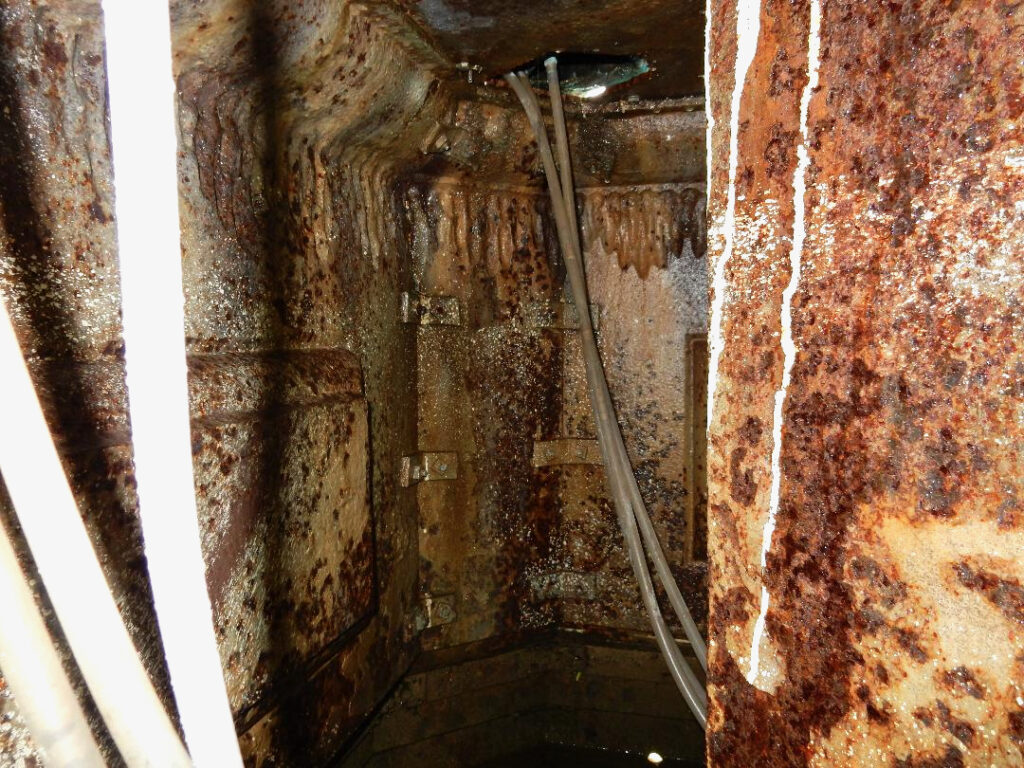
Rust is depicted within the interior of the Birge Fountain, one of four landmarks in need of repair, according to members of the Whitewater Landmarks Commission. Contributed/Kori Oberle.
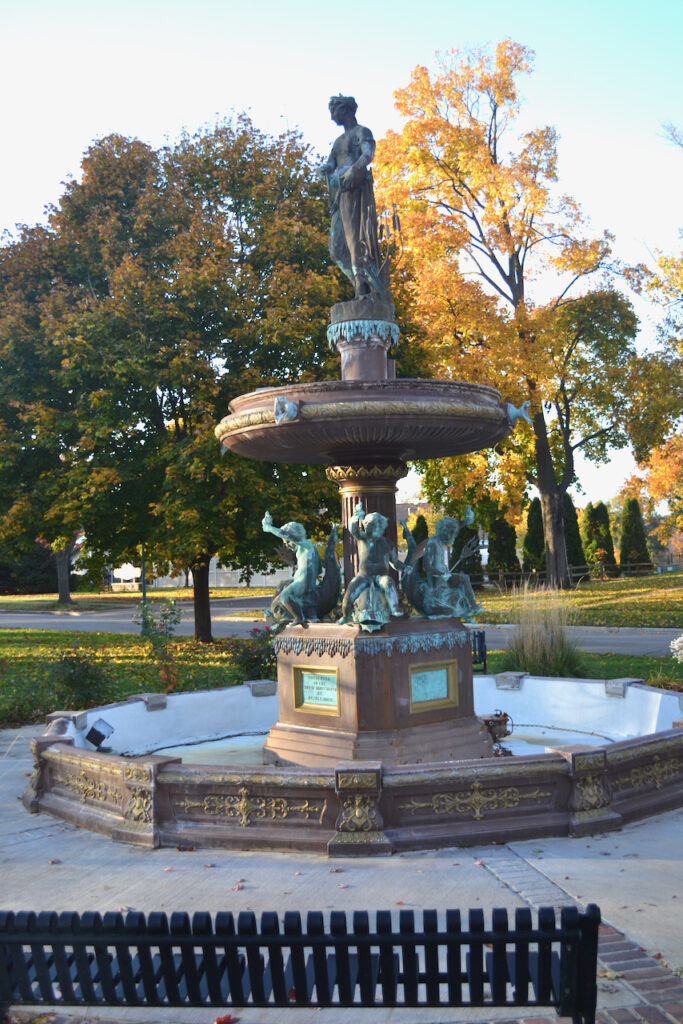
An image of the Birge Fountain in downtown Whitewater, as shared Tuesday by Whitewater Landmarks Commission member Kori Oberle, offers a glimpse of the structure when it is not filled with water. The fountain is among city-owned landmarks identified by the commission as in need of repair. Contributed/Dan Richardson.
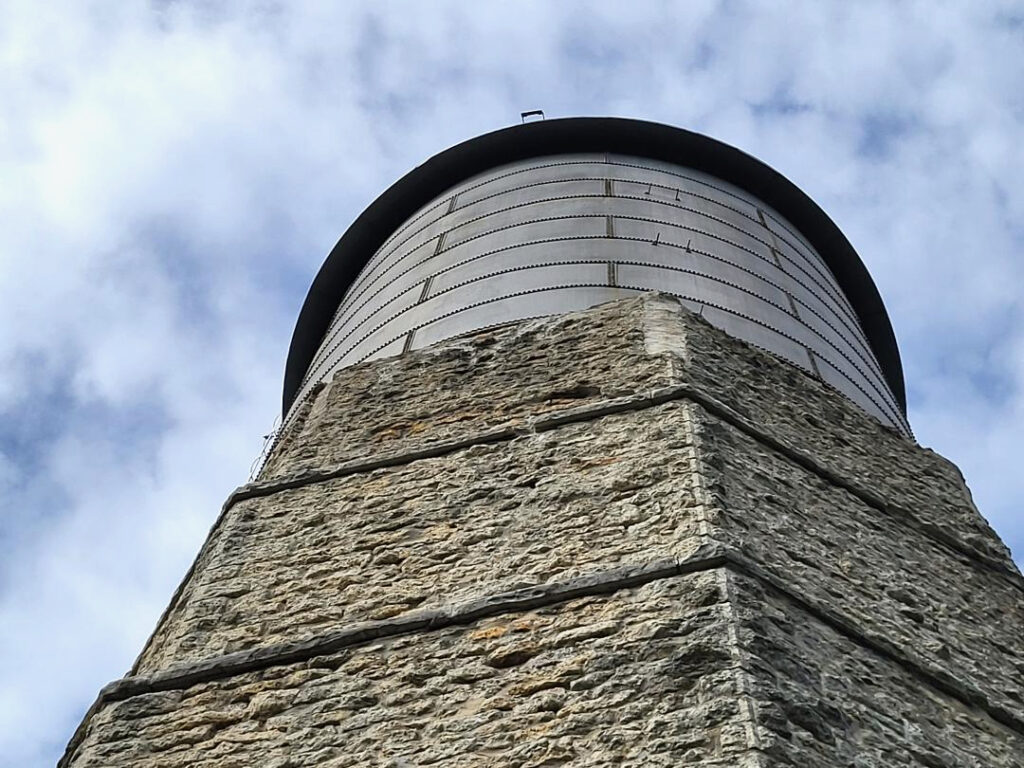
A piece of rock from the exterior of the historical water tower in Whitewater’s Starin Park is shown to be missing. The tower, which was recently decommissioned, is among landmarks identified by the city’s Landmarks Commission as in need of repair. Contributed/Kori Oberle.
This post has already been read 2291 times!
